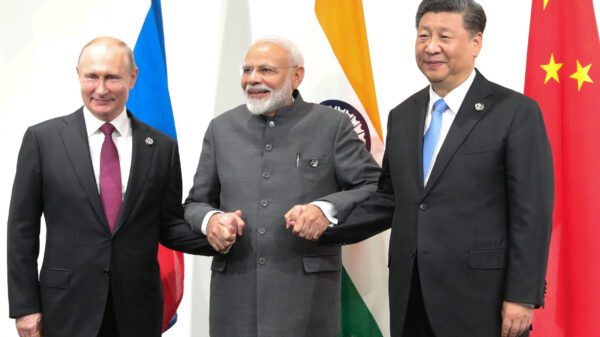How is Dragon getting beat in this war of chips between America and China
For more than a century, the struggle over oil has spawned numerous wars, unusual alliances and diplomatic tensions.
Now the two biggest economies of the world are standing face to face for another valuable thing and that is semiconductors. This is the chip which is really a force in our daily life.
This tiny piece of silicon is the center of a $500 billion industry that is expected to double in value by 2030. And who controls its supply chain.
This is also a reasonable question in which there is an intricate network of companies and countries that make them. Control of its supply chain is the key that can make someone an unmatched superpower.
China wants the technology to make these chips. For this reason America, which is keeping most of the source of this technology with itself, is pushing Beijing back. Chris Miller, associate professor at Tufts University and author of Chip Wars, says that both countries are clearly involved in an arms race in the Asia Pacific region.
He goes on to say but there is much more to the race. He says, “Both are racing in the traditional areas of how many ships and missiles one has and increasing them, but they are also engaged in improving the quality of artificial intelligence (AI) algorithms so that they can be applied in military systems.” Can go.”
At present America seems to be winning but the declared chip war against China is giving a new shape to the global economy.
chip-makers
Making semiconductors is complicated. It requires expertise. iPhone chips are designed in the US, made in Taiwan, Japan or South Korea and then assembled in China.
India is investing a lot in this industry which can further play the role of a big player in future.
Semiconductors were invented in America but over time East Asia emerged as its manufacturing hub. The reason for this was the incentives and subsidies of the governments there.
Because of this, Washington made strategic partnerships to develop this trade in the region as it had weak relations with Russia since the time of the Cold War.
It is still important for the US after China’s growing clout in the Asia-Pacific region. Now the race is on to make these chips smaller and more efficient on a large scale.
The challenge now is how many transistors can fit on a small silicon wafer that can switch on and off automatically.
“That’s why the semiconductor industry calls it Moore’s Law, especially doubling transistor density over time, and that’s a very difficult target,” says Zui Wang, partner at Bain & Company in Silicon Valley.
“It makes our phones faster, our digital photo archives bigger, our smart home devices smarter over time, and our social media content expands.”
world’s largest chip maker
It is not easy to make even for top chip-makers. In the middle of 2022, Samsung became the first company that was successful in making three nanometer chips.
At the end of the same year, Taiwan Semiconductor Manufacturing Company (TSMC), the world’s largest chip maker as well as Apple’s largest supplier, was able to do the same.
How small is it? It is smaller than the edge of a human hair, which is 50 to 100,000 nanometers fine. These small ‘special edge’ chips are very powerful.
This means that it will go to very expensive devices, including things like internet-connected supercomputers and AI.
The market for these chips is also very profitable as it adds speed to our daily life, they are used in microwaves, washing machines and refrigerators. But its demand is likely to decrease in future.
Most of the world’s chips are currently made in Taiwan, which is a self-governing island and its president calls it the ‘Silicon Shield’. In other words, it gives it protection from China as it claims Taiwan.
Miller says that Beijing also produces chips based on national priority and is increasingly using them in supercomputers and AI.
It is nowhere in the race to become a global leader in this matter, but in the last decade it has caught pace in this area, especially in terms of chip design capability.
He says, “Historically you will find that whenever a powerful country acquires advanced computing technology, it adopts it in intelligence and military systems.”
Because of this and due to dependence on Taiwan and other Asian countries, America is accelerating its construction.
How America is stopping China’s progress?
The Biden administration is trying to block China in the technology of making chips.
Last October, Washington announced some rules to control it, in which China was prohibited from selling chips, chip-making equipment, and US software to companies.
America’s decision was applicable to all the companies of the world. In this decision, US citizens and permanent residents were banned from producing or developing chips in China’s permanent factories.
This hit China hard because its nascent chip-making industry is dependent on imports of hardware and new technology.
The ASML company of the Netherlands has suffered a loss of one-fourth because it used to earn this from China. It is the only company that has state-of-the-art lithographic machines that produce extremely fine chips.
“Talent is the most important factor in this area. If you look at semiconductor companies in China, most of the executives there have US passports, they’ve been trained in the US and have green certificates,” says Lingao Bao, analyst at the policy research firm Trivium China. There are cards. That is why it is a big problem for China.
America also wants to make a lot of chips. Under The Chips and Science Act, $53 billion is given in the form of subsidies and grants to companies making semiconductors in the US. Big players in this field are taking advantage of this.
TSMC is investing $40 billion in two plants in the US, its only plant outside Taiwan.
Memory chips are required for supercomputers, military hardware, and any device with a processor. Micron, America’s largest maker of memory chips, has announced that it will invest $100 billion over the next 20 years in its computer chip plant on the outskirts of New York.
Sanjay Mehrotra, chief executive of Micron Technology, says, “The Chips Act compensates for the cost difference in manufacturing in the US versus Asia. Micron will continue to invest in its plants in Asia. There are many levels of competition in the field.”
china game
America’s sanctions are harming China where it wants.
Under the shadow of sanctions, Apple has reportedly canceled the deal to buy memory chips from China’s most successful chip company Yangtse Memory Technology Corp (YMTC).
Bao says that Khwae is trying to figure out how to deal with it.
They say that this telecom giant, the world’s second largest smartphone maker after Samsung, is ‘virtually dead’.
“That’s why it was easy for Washington to cripple a Chinese technology company. China really has nothing to answer for. In the past, the US used to target a few Chinese companies, but this time it has targeted the entire country.” spread it.”
Can China respond to this? By blocking goods or services or by imposing export controls, it can harm itself because the economy is already sluggish.
Beijing has complained to the World Trade Organization (WTO) but it may take years to resolve.
Meanwhile, experts say China will double down on investment and support its domestic chip maker industry.
At the 20th Congress of the Chinese Communist Party in October, President Xi Jinping said, “We will focus on national strategy, strengthen indigenous scientific and technological research, and resolutely win the battle to acquire key technology.”
Now what next?
In short, this industry is also struggling with the global slowdown caused by the war in Ukraine, rising inflation and the reopening of China’s economy.
After battling the Kovid epidemic, Beijing is taking steps forward cautiously regarding its economy.
Miller says, “There is going to be a lot of tug-of-war between American, Taiwanese, Chinese and the rest of the world companies. All this will be seen in cutting-edge logic and memory chips. Where we will see America making efforts where it can innovate China. Would like to keep away from US’s network. At the same time, China will try to build its own supply chain which is free from America.
They say that this can create an ecosystem in which China will be on one side and the whole world will be on the other side.
The global economy will have a great impact on this. This will force the big players in the sector to choose their side, possibly preventing many from going to the Chinese market.








